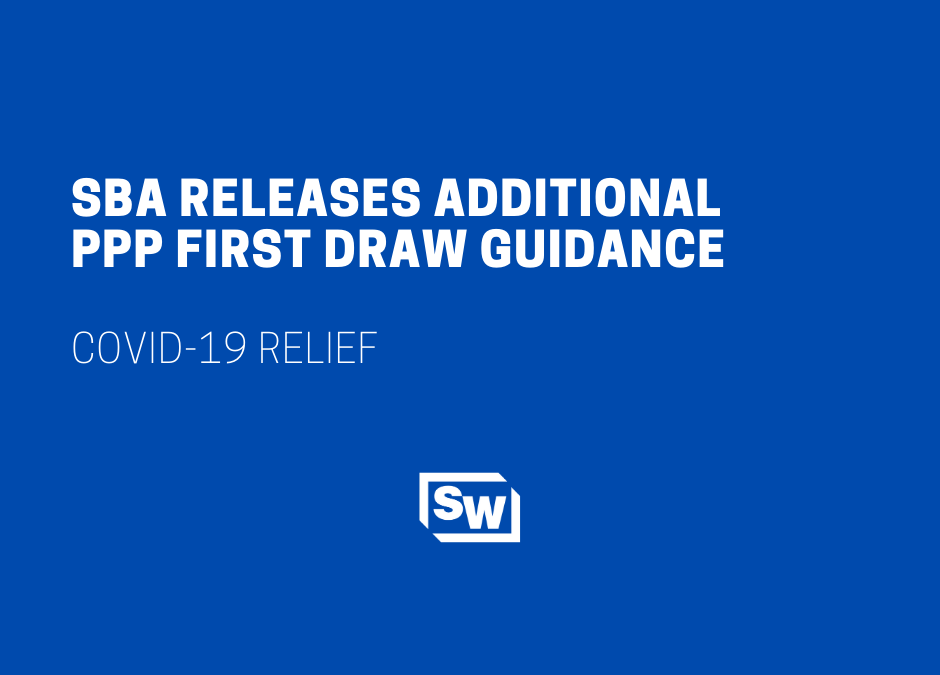On January 7, 2021, the SBA issued guidance regarding the extension of the Paycheck Protection Program (PPP) under the Economic Aid Act. Separate guidance was issued for first-time borrowers (First Draw) and borrowers seeking a second round of PPP funding (Second Draw). Information on Second Draw PPP loans can be found here.
First-time borrowers can apply for loans with participating financial institutions. Inquiries regarding applications should be directed to the institution where the applicant maintains their banking relationship. Borrowers who received a PPP loan in 2020 are considered to have received a First Draw PPP loan and are ineligible for another First Draw PPP loan. However, they may be eligible for a Second Draw PPP loan. (Also, see the exceptions at the end of this summary).
The basic facets of the First Draw program are as follows:
- The program is open to small businesses (corporations and partnerships), independent contractors, sole proprietors, self-employed (Schedule C filers), tax-exempt non-profit 501(c)(3)organizations, veterans organizations described in 501(c)(19), Tribal business concerns, housing cooperatives, destination marketing organizations, 501(c)(6) organizations certain news organizations and nonprofit broadcasting entities. Section B(1)(g) of the guidance, beginning on page 19, lists industry-specific eligibility issues.
- Borrowers will be required to make a “good faith” certification that economic uncertainty makes the loan request necessary to support ongoing operations.
- Generally, the business (including affiliates) can employ no more than 500 employees. A 300-employee limit applies to housing cooperatives, destination marketing organizations, and 501(c)(6) organizations.
- Applicants must have been in operation on February 15, 2020, and have paid employee wages, or be an eligible independent contractor, sole proprietor, or self-employed person with no employees.
- The maximum amount of the loan is the lesser of $10 million or an amount based on a payroll-based formula. The loan amount is generally determined by calculating 2.5 times the average monthly payroll, based on 2019 or 2020 payroll. Qualifying payroll is capped at $100,000 per individual.
- For schedule C filers with no employees, the loan amount is determined by dividing line 31 of their 2019 or 2020 schedule C by 12 and multiplying by 2.5. Line 31 cannot exceed $100,000 for purposes of the calculation.
- Additional guidance on calculating the maximum loan amount for seasonal employers, farmers, and partnerships is in sections 4c through 4e beginning on page 37.
- The loans are subject to full forgiveness based on utilizing loan proceeds for permitted purposes over the “covered period” of the loan. This is a period that begins when the loan is disbursed and ends either 8 weeks or 24 weeks after disbursement, as selected by the borrower.
- The proceeds of the loan can be used for:
- Payroll costs
- Certain costs related to providing health and welfare benefits.
- Mortgage interest
- Rent
- Utilities
- Interest on other debt incurred prior to February 15, 2020
- Refinancing an SBA EIDL loan made between January 31, 2020 and April 3, 2020.
- Payments for business software or cloud computing expenses that facilitate business operations.
- Covered supplier costs
- Covered property damage costs
- Covered worker protection expenditures
At least 60 percent of loan proceeds must be used to cover payroll costs.
- Loan forgiveness is determined based on 1) maintaining employee and compensation levels over the 8- or 24- week covered period, 2) using at least 60 percent of the proceeds for qualifying payroll costs and 3) using any remaining proceeds, up to 40 percent, for other allowable costs. Borrowers will be required to apply for forgiveness through their lender utilizing an SBA approved format. Both the initial application and the forgiveness application will require supporting documentation per lender and SBA requirements.
- Loans that are not forgiven must be repaid within 5 years and bear annual interest at 1 percent.
The guidance does provide a “do-over” for certain entities or self-employed individuals that may have previously applied for and received proceeds from a PPP loan. These include:
- Partnerships that did not include a consideration for partner compensation in their original request.
- Seasonal employers subject to a revised calculation described in subsection B(4)(c).
- Borrowers who returned all or part of a PPP loan or did not accept the full amount of a PPP loan. This latter category would be eligible to receive an increase up to the amount originally approved.
The SBA guidance described in this summary can be found here.
The SBA guidance on how to calculate the maximum First Draw PPP loan amount and what documentation should be provided can be found here.
If you have any questions, please reach out to your Sciarabba Walker contact person or email info@swcllp.com.

